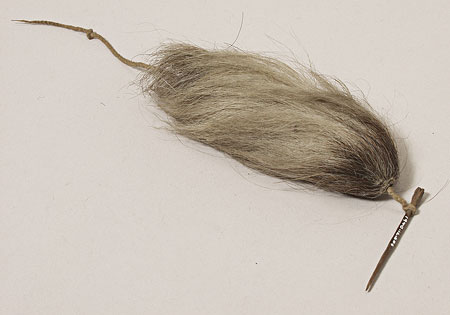Accession Number:
1940.12.606
Country:
Sudan
Region:
[Southern Sudan] ?Northern Bahr el Ghazal ?Western Bahr el Ghazal ?Warab ?El Buheyrat ?Western Equatoria
Cultural Group:
Agar Dinka
Date Made:
By December 1927
Materials:
Wood Plant , Goat Hair Animal , Goat Skin Animal , Animal Tail , ?Cotton Yarn Plant , String
Process:
Twisted , Tied
Dimensions:
Max L [pin] = 51 mm Max W [pin head] = 4 mm Max Th [pin head] = 2.8 mm Max W [pin body] = 1.5 mm Max L [cord] = 195 mm Max Diam [cord] = 1 mm Max L [tassel group] = 110 mm Max W [tassel group] = 39 mm [RTS 13/5/2004].
Weight:
5.1 g
Other Owners:
Collected by Vere Henry Fergusson, presumably at some time between 1916, when he was posted to the Equatorial batallion of the Egyptian army, and December 1927 when he died in the Sudan. Acquired by Charles Gabriel Seligman and donated to the Pitt Rivers
Field Collector:
Vere Henry Fergusson
PRM Source:
Charles Gabriel Seligman or Brenda Zara Seligman
Acquired:
Donated 1940
Collected Date:
Between 1916 and December 1927?
Description:
Hair ornament consisting of a short pin or thorn with roughly shaped, rectangular sectioned head, irregularly flat across the top, tapering to form a narrow body with a sharp point at the other end.
This is a mid brown colour (Pantone 462C).
It is not clear if this pin occurs in this form naturally, or whether the shape has been modified.
A length of light yellowish brown cord has been tied to the pin just below its head (Pantone 465C).
This is made of two twisted fibrous strands, possibly cotton.
A series of around 18 goat hair tassels have been fitted onto the cord, one above the other, with a knot tied in the cord below the last tassel to keep them secured in place.
Each tassel is made from a circular ring cut from the animal's tail, with hair springing out from naturally from the skin.
They range in colour from a dark brown to a light buff (Pantone 476C to 7506C).
A final knot has been tied in the cord just above its end.
The pin and cord seem to be complete, but some of the hair is missing from the tassels, while there are small pieces of dirt adhering in places.
The pin is 51 mm long, with its head measuring 4 by 2.8 mm and its body having a diameter of 1.5 mm; the cord has a length of 195 mm and a diameter of 1 mm, while the tassel group is 110 mm long and 39 mm wide.
The skin rings that make up the head of each tassel are around 7 mm in diameter.
The entire object weighs 5.1 grams.
Collected by Vere Henry Fergusson, presumably at some time between 1916, when he was posted to the Equatorial battalion of the Egyptian army, and December 1927 when he died in the Sudan. Acquired by Charles Gabriel Seligman and donated to the Pitt Rivers Museum in 1940.
This ornament was worn in the hair by cattle owners, and came from the Agar Dinka. S.L. Cummins described the Agar Dinka as occupying territory from Naburi to Rumbek, primarily along the Nam river. They were said to be one of the richest, most numerous and most warlike Dinka tribes (S.L. Cummins 1904, "Sub-tribes of the Bahr-el-Ghazal Dinkas", JRAI 34, 149)0
Rachael Sparks 26/9/2005.
Collected by Vere Henry Fergusson, presumably at some time between 1916, when he was posted to the Equatorial battalion of the Egyptian army, and December 1927 when he died in the Sudan. Acquired by Charles Gabriel Seligman and donated to the Pitt Rivers Museum in 1940.
This ornament was worn in the hair by cattle owners, and came from the Agar Dinka. S.L. Cummins described the Agar Dinka as occupying territory from Naburi to Rumbek, primarily along the Nam river. They were said to be one of the richest, most numerous and most warlike Dinka tribes (S.L. Cummins 1904, "Sub-tribes of the Bahr-el-Ghazal Dinkas", JRAI 34, 149)0
Rachael Sparks 26/9/2005.
Primary Documentation:
Accession Book Entry
[p.
468]
The late Professor C.G.
SELIGMAN, M.D., F.R.S.
Miscellaneous collection presented in part by himself, June, 1940, and in part, after his death, by Mrs B.Z.
Seligman, October, 1940.
[p.
500] 1940.12.606 - Ornament consisting of wooden pin and a bundle of goat’s hair, worn in the hair by cattle owners.
AGAR DINKA tribe, BAHR EL GHAZAL PROV., A[nglo].E[gyptian].
SUDAN.
Colld.
by Capt.
V.
Fergusson.
Card Catalogue Entry - There is no further information on the catalogue card [RTS 9/3/2004].
Old Pitt Rivers Museum label - Ornament worn in the hair by cattle owners. AGAR DINKA tribe, BAHR EL GHAZAL PROV. A.E. SUDAN. Colld by Capt. V. Fergusson, d.d. Dr C.G. Seligman [rectangular metal-edged tag, tied to object, RTS 13/5/2004]. [reverse:] 1940.12.606 [EC 'DCF 2004-2006 What's Upstairs?' 7/10/2005]
Card Catalogue Entry - There is no further information on the catalogue card [RTS 9/3/2004].
Old Pitt Rivers Museum label - Ornament worn in the hair by cattle owners. AGAR DINKA tribe, BAHR EL GHAZAL PROV. A.E. SUDAN. Colld by Capt. V. Fergusson, d.d. Dr C.G. Seligman [rectangular metal-edged tag, tied to object, RTS 13/5/2004]. [reverse:] 1940.12.606 [EC 'DCF 2004-2006 What's Upstairs?' 7/10/2005]



